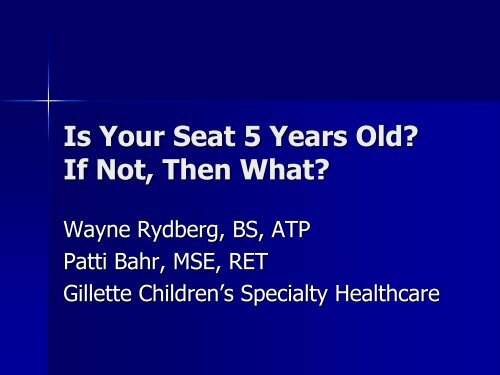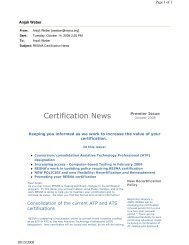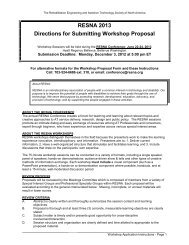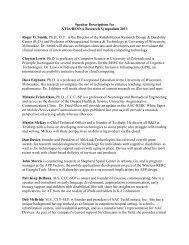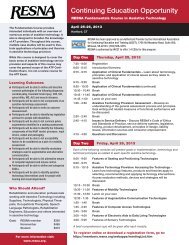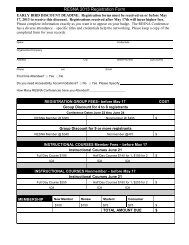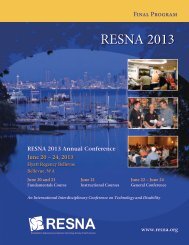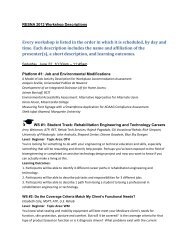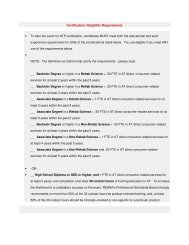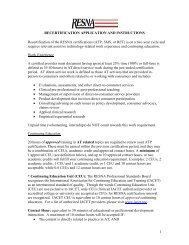Is Your Seat 5 Years Old? If Not, Then What? - Resna
Is Your Seat 5 Years Old? If Not, Then What? - Resna
Is Your Seat 5 Years Old? If Not, Then What? - Resna
Create successful ePaper yourself
Turn your PDF publications into a flip-book with our unique Google optimized e-Paper software.
<strong>Is</strong> <strong>Your</strong> <strong>Seat</strong> 5 <strong>Years</strong> <strong>Old</strong>?<br />
<strong>If</strong> <strong>Not</strong>, <strong>Then</strong> <strong>What</strong>?<br />
Wayne Rydberg, BS, ATP<br />
Patti Bahr, MSE, RET<br />
Gillette Children’s Specialty Healthcare
Objectives<br />
• Define a strategy for collecting useful data<br />
on risks for development of pressure ulcers<br />
• Describe a strategy for adjusting or<br />
repairing products with consumers and their<br />
family members<br />
• Identify specific documentation<br />
recommended for systems under 5 years, if<br />
needed
Gillette History<br />
• First publicly funded hospital in the<br />
nation for “crippled and indigent<br />
children” – 1897<br />
• State hospital to <strong>Not</strong> for Profit – 1977<br />
• Lifetime Clinic – 2001<br />
• United Cerebral Palsy Affiliate - 2012
Gillette Today<br />
• Inpatient hospital - 2,328 inpatients in 2012<br />
• Outpatient clinics - 147,984 visits in 2012<br />
– 5 clinics in Twin Cities metro<br />
– 3 clinics in greater Minnesota<br />
– Mobile Outreach Clinic - 17 communities in<br />
greater Minnesota<br />
• In the past 10 years, Gillette has served patients<br />
– every (89) Minnesota county<br />
– 48 of the United States<br />
– 4 Canadian provinces<br />
– 30 other countries
Gillette Culture<br />
• <strong>Not</strong> for Profit<br />
• Local competition is free for service<br />
• Mostly CP kids with Medicaid or some<br />
combination of private insurance & MA<br />
• Traditionally a small population of Medicare<br />
patients
Lifetime Specialty<br />
Healthcare since 2002<br />
• Lifetime Growth (new site too)<br />
– 2002 844<br />
– 2007 5,746<br />
– 2012 8,449<br />
• Medicare patients increasing<br />
accordingly<br />
• Patients 18+ were 22.7% of Gillette<br />
population in 2011
Historical <strong>Seat</strong>ing at Gillette<br />
• History – since early 1980s<br />
• Culture – provide same day service<br />
– <strong>If</strong> MD requests<br />
– <strong>If</strong> patient lives outside of Twin Cities<br />
– <strong>If</strong> you have time (retro PAs OK if MMA)<br />
• 80/20 Guideline<br />
– Before 2011, Medicare was less than 20%
<strong>Seat</strong>ing at Gillette<br />
• Sitting Support Orthosis (SSO)<br />
developed from Orthotic Lab<br />
• Upholstered Sitting Support Orthosis<br />
(USSO)<br />
• SureFit<br />
• Custom Firm <strong>Seat</strong>s and Backs<br />
• Contoured Foam
Current <strong>Seat</strong>ing at Gillette<br />
• Continue to provide same day adjustments<br />
and repairs<br />
• 90% of people are pressure mapped<br />
– 10% have SSOs (visual check), have good skin,<br />
healthy tissue, adequate bottoms, use briefs<br />
• Over 1000 <strong>Seat</strong>ing & Mobility Evals yearly<br />
• Over 600 new seats yearly
Referrals<br />
• Ongoing seating care<br />
– Internal MD/NP for check-ups, yearly (or sooner)<br />
– <strong>Seat</strong>ing only services<br />
• New seating services<br />
– New patients to organization<br />
– Commercial seating doesn’t work<br />
– Pressure issues needing topical, nutritional, and<br />
custom seating support
Pressure <strong>Is</strong>sues Addressed<br />
• Wound Care Committee for Inpatients<br />
– Nurse Practitioner (NP)<br />
– <strong>Seat</strong>ing Practitioner<br />
– Nurse<br />
• Community Network<br />
– Wound Care Nurse<br />
– Plastic Surgeon<br />
– NP at Regional Hospital
Find Origin of a Wound<br />
• History<br />
• Other Questions<br />
– Previous ulcers – Toileting/shower<br />
– Medical condition routine<br />
• spine/pelvic asymmetry – Sleep routine<br />
• incontinence<br />
– Skin check routine<br />
• nutrition<br />
– Hours in chair<br />
• <strong>What</strong> has changed? – Pressure relief<br />
– Medical concerns<br />
routine<br />
– Medications<br />
• Micro Climate<br />
– Transfers<br />
– Nutrition<br />
– Care givers<br />
– Moisture<br />
– Weight gain/loss – Heat
<strong>Seat</strong>ing and Mobility<br />
Evaluations (1,000 yearly)<br />
(Exemption from Lifetime criteria)<br />
• OT or PT<br />
• <strong>Seat</strong>ing Practitioner<br />
• Durable Medical Equipment Vendor of<br />
patient’s choice<br />
• Others
<strong>What</strong> we Compared<br />
• UNDER 5 years old<br />
Medicaid or Private<br />
– # Paid<br />
– # Denied<br />
• OVER 5 years old<br />
Medicaid or Private<br />
– # Paid<br />
– # Denied<br />
• UNDER 5 years old<br />
Medicare<br />
– # Paid<br />
– # Denied<br />
• OVER 5 years old<br />
Medicare<br />
– # Paid<br />
– # Denied
Data Collected on 255 Fittings<br />
Aug 2011 – Jan 2012<br />
• Diagnosis<br />
• Primary/secondary insurance<br />
• Existing seating system at evaluation<br />
• Age of existing seating system<br />
• Adjustments to seating system<br />
• Type of new seating system recommended<br />
• Reason for needing new seating system
Data Excluded from Study<br />
• Only private insurance (14)<br />
• MC and never had seating before (10)<br />
• MA and never had seating before (8)<br />
• No billing information found (6)<br />
• Patient died (1)<br />
Also,<br />
<strong>If</strong> unable to determine how old existing<br />
system was, included in under 5 years.
Results<br />
• UNDER 5 years old<br />
Medicaid or Private<br />
– 80 (100%) Paid<br />
– 0 (0%) Denied<br />
• OVER 5 years old<br />
Medicaid or Private<br />
– 35 (100%) Paid<br />
– 0 (0%) Denied<br />
• UNDER 5 years old<br />
Medicare<br />
– 48 (76%) Paid<br />
– 13 (21%) Denied<br />
– 2 (3%) in Appeal<br />
• OVER 5 years old<br />
Medicare<br />
– 28 (74%) Paid<br />
– 10 (26%) Denied
Discussion of Results<br />
• 115 with Medicaid<br />
– all paid (according to contractual agreement)<br />
– age of seat did not matter<br />
• 101 with Medicare<br />
– 76 paid<br />
• 48 (63%) under 5 years<br />
• 28 (37%) over 5 years<br />
– 23 denied<br />
• 13 (57%) under 5 years<br />
• 10 (43%)over 5 years
Discussion of Results<br />
• 101 with Medicare (only or combination)<br />
– 76 paid<br />
• 48 under 5 years old<br />
– 23 (48%) from commercial to custom seat (different<br />
HCPCS code)<br />
• 28 over 5 years<br />
– 15 (54%)from commercial to custom seat (different<br />
HCPCS code)
Discussion of Results<br />
• 101 with Medicare (only or combination)<br />
– 23 (23%) denials (11% of overall)<br />
• 9 – no billing information or missed filing date<br />
• 7 – managed care or skilled nursing facility<br />
• 2 – lack of information<br />
• 2 – no one paid<br />
• 2 – same and similar
Conclusion<br />
• Better screening of living situation needed<br />
• Internal billing needs to be monitored<br />
• Further investigation of amount paid needed<br />
• Five year window importance was<br />
inconclusive<br />
• Documentation must support need for seats<br />
– even if they are less than 5 years old
Documentation: Reason<br />
for needing new seat<br />
• Existing seat does not provide sufficient<br />
support<br />
• Mobility base change<br />
• Posture or anatomical measurements<br />
change<br />
• Existing seat worn or broken<br />
• Existing seat does not provide proper<br />
pressure relief or management<br />
• Other (weight change, medical change)
Reason for New <strong>Seat</strong>ing<br />
Medicaid (MMA)<br />
• PAID (115)<br />
– 54 Base change<br />
– 52 Support<br />
– 34 Anatomical change<br />
– 21 weight increase/growth<br />
– 20 Pressure relief<br />
– 15 Worn/broken 4 weight decrease<br />
– 4 medical change<br />
(Total is greater than 115 because more than<br />
one reason could be used for justification.)
Reason for New <strong>Seat</strong>ing<br />
Medicare (MC) UNDER 5<br />
• DENIED<br />
– 11 Support<br />
– 7 Base change<br />
– 5 Anatomical<br />
change<br />
– 3 Worn/broken<br />
– 8 Pressure relief<br />
– 1 Weight gain<br />
• PAID<br />
– 33 Support<br />
– 23 Base change<br />
– 18 Anatomical<br />
change<br />
– 12 Worn/broken<br />
– 18 Pressure relief<br />
– 9 Weight Gain
Reason for New <strong>Seat</strong>ing<br />
Medicare (MC) OVER 5<br />
• DENIED<br />
– 7 Support<br />
– 4 Base change<br />
– 4 Anatomical<br />
change<br />
– 6 Worn/broken<br />
– 5 Pressure relief<br />
– 2 Weight gain<br />
• PAID<br />
– 19 Support<br />
– 15 Base change<br />
– 13 Anatomical<br />
change<br />
– 23 Worn/broken<br />
– 13 Pressure relief<br />
– 3 Weight gain<br />
– 1 Weight loss
Other Findings<br />
• Of SSOs replaced<br />
– average age of seat = 6 years
Documentation for seats<br />
• Therapy<br />
– Medicare qualifications included in templates for<br />
new electronic medical record<br />
• Why is new w/c needed?<br />
• Why is new seat needed?<br />
• Prefabricated seat does not meet the needs of patient<br />
because . . .<br />
• <strong>Seat</strong>ing Practitioner<br />
– Each code identified and possible reasons for<br />
justification available to practitioner
<strong>Seat</strong>ing Sample Charting<br />
Electronic Medical Record
Therapy Sample Charting<br />
Electronic Medical Record
Billing Cycle<br />
• Evaluation<br />
• Prior Authorization with little<br />
information<br />
• More information requested<br />
• Send Therapist note<br />
• Send Letter of Medical Necessity<br />
signed by MD/NP<br />
• Send <strong>Seat</strong>ing Practitioner note
How Practice Has Changed<br />
• Discussions with consumers and family<br />
– Age of chair<br />
– Age of seat<br />
– Age of components<br />
– ABN needed to bill secondary insurance<br />
• Vendor communication<br />
• Gather information on residence
How Practice <strong>Is</strong> Changing<br />
• Repairs/adjustments<br />
– Fewer same day<br />
– Educate practitioners about need to adjust<br />
before ordering new<br />
• Intake Person<br />
– Insurance check before eval<br />
– Identify age of seat, diagnosis, place of<br />
residence, guarantor<br />
– Insurance check before fit
Insurance Check<br />
• Medicare part A and B<br />
• Medicare supplemental HMO/MCO<br />
– Which is primary?<br />
• Check<br />
– 270/271<br />
– Stonebridge<br />
– IVR line<br />
– Connex (soon)
Consumer & Family<br />
Conversations<br />
• Evaluations – culture of expecting new<br />
– New chair and transfer seat<br />
– Wait until chair/seat 5 years old<br />
– May need to repair/adjust until 5 years old<br />
– <strong>If</strong> can’t, this may be justification for new<br />
– <strong>If</strong> under 5 years, may be harder to justify<br />
• Insurance review<br />
– Commercial to custom may be paid (different HCPCS<br />
code)<br />
– <strong>If</strong> Medicare criteria not met, ABN needed to bill secondary<br />
insurance
Future Work<br />
• Function not part of the data<br />
– Study w/ therapy<br />
• Determine functional measurements w/ OT<br />
• Have OT test function in current chair/seat<br />
• Have OT test function after new system<br />
provided to:<br />
– Ensure function not decreased<br />
– Measure and document increased function
Thank You<br />
• Wayne Rydberg<br />
– 651 634 1902<br />
– wrydberg@gillettechildrens.com<br />
• Patti Bahr<br />
– 651 634 1911<br />
– pbahr@gillettechildrens.com


